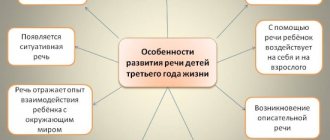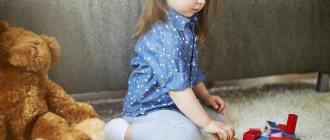Speech is a form of communication between people using linguistic structures. When a child is born, he does not know how to do anything and the task of an adult is to teach him everything. Teach to walk, hold a spoon, a mug, go to the potty and talk. While everything else is more or less clear, parents always have a lot of questions regarding speech. What to do if the child does not speak? If he speaks “his” language? And many, many different questions. Today we’ll talk about speech development, speech delays, examinations and more.
About speech understanding
Speech understanding is one of the criteria for assessing a child’s speech, and no less important. The child may not speak, but can fully understand speech.
Speech comprehension should also be age-appropriate.
How to determine that a child understands speech?
The assessment of the speech understanding criterion occurs at 1 month of the child’s life.
- At 1 month, the baby flinches from a voice or sound.
- At 2 months, expresses anxiety about sounds or voices.
- At 3 months, looks at the speaker.
- At 4 months, he turns his head towards the speaker and stops crying when he is reassured by speech.
- At 5 months he begins to respond to his name, but this is only if he was previously addressed by name, and not just “baby”, “bunny” and so on, otherwise he will respond to the baby and the bunny.
- At 6 months he stops when he hears the word “no” and begins to use gestures. This does not mean that the child understands what you mean by “no.” Gestures are one way of speaking, for example, when a baby reaches out to be picked up.
- At 7 months, looks at a familiar object when it is named. Use question designs like: “Where is the bird?” Where's dad? We also teach the concept no: “Where is the bird?” - the child looks at the sky - “there is no bird.” And we show our heads no. At 7 months, the child realizes where he is; to do this, we bring him to the mirror, look at him and show him, calling him by name.
By the age of one year, a child’s vocabulary is 5-9 words, of course, it can be more. These words do not appear immediately at 12 months, but gradually. The first words can appear at 6-7 months, such as “whoa - cat”, “bang - fell”, “ss - chest” and the like. If all this is missing, it is too early to talk about delayed speech development, check your hearing and continue to develop and educate your baby.
There may be not a single word at all, and this will also be a variant of the norm, since the assessment is also determined by the understanding of speech.
It is not normal if per year:
- no babble
- does not point to the object
- does not use gestures.
You can't tell a child
- I don't understand you,
- what are you whispering there?
- speak louder and clearer!
The child should know that you always understand him, even without words.
If the child’s speech level does not correspond to the norm, most likely he was not taught and this is also a variant of the norm. It is possible to train.
How to develop the speech abilities of two-year-olds
Even if a child is recommended to have classes with a speech pathologist (sometimes expensive), at the age of two they are short-term. The baby does this activity for 10-15 minutes. Exercises are organized only in the form of a game and can be successfully performed by parents independently. It must be remembered that the baby will require increased activity from adults. It is necessary to pronounce each of your actions, ask, call for a conversation, answer questions, motivate, pronounce words together.
Exercises are carried out only with positive emotions, as in this case there will be results. In order to consolidate a skill, repeated repetitions are necessary. In games, be sure to use visual material, bright toys, pictures that will interest the baby’s attention. It would also be a good idea to take into account the child’s experience of understanding the world around him, not to utter incomprehensible words, and not to construct long sentences. Shorten words by pointing to objects. Material for games is selected according to the principle from simple to complex. Classes should include a variety of activities aimed at developing specific skills.
For the slightest achievements of the baby, hug, kiss, show emotions, since a child, even at this age, is already able to establish cause-and-effect relationships. If mom is happy, then we need to “do it again”! The baby learns about the world by imitating adults, and therefore in the game you should interest your silent child as much as possible.
Choosing games
The main task of an adult is to teach the child to imitate. The main principle of learning is gradualism and slowness.
- “Let’s do exercises.” The point of the game is that the adult comes up with exercises that the baby would repeat and perform with him: clapping, jumping, steps, swinging his arms and legs. At first, the movements are performed separately, then the material becomes more complex and additional ones are added, for example, clapping your hands and walking in place.
- Fun logorhythmics. These are musical games for developing the rhythm and feeling of music, as well as the use of simple words for movements: “Clap-clap, stomp-stomp.” An adult must pronounce all actions to the music. Such activities have a beneficial effect on the child’s speech and motor development and allow them to quickly achieve a positive effect and emotional response, especially if they are performed together with their beloved mother.
- "Games with objects." For example, we bathe the Katya doll. Mom pronounces each action: “Let's take the doll, undress her, and then put her in the bath. Let’s pour some lukewarm water so that the doll will be pleased...” We define the process as much as possible, and the necessary attributes for the game, such as a bathtub and water, will help make the process interesting and captivating the child’s attention. Your baby will definitely begin to imitate actions, and subsequently try to pronounce words with you.
- Nursery rhyme games. It’s not for nothing that our great-grandmothers knew all kinds of jokes filled with folklore. Such sayings are easy to remember and repeat, and are most understandable to children with their simple rhythms. They are used in the development of speech of two-year-old children. “Okay-okay”, “Guli-guli” and much more.
- Games with small objects. Training fine motor skills directly related to the speech areas of the cerebral cortex. Invite your little one to tear together a sheet of colored paper into small pieces, and then assemble some kind of composition from them, being sure to praise your little helper. During joint activities, pronounce each action, for example, “drip-drip, it began to rain, whew-fuh, the snow flew, rust-shur, the wind blew.”
- You can build a finger pool from various safe small fillers, and, under close supervision, “bathe” small fingers, talking through what is happening.
- Get your little one used to reading children's books together. To begin with, you need books without text, with bright, large, colorful pictures; music books help best here. When showing pictures, we describe what we have drawn in our own words, pay attention to the details, stop, examine, and pronounce. Then you can use illustrated books with short poetic summaries written in capital letters so that the baby gets used to the fact that books can be read and listened to.
- "Sounds of animals and objects." You can use animal model toys, or you can use painting material. "Who is this? Hen! What does the chicken say? Ko-ko-ko." "What is this? Airplane! How does the plane sound? Oooh." Such exercises significantly develop the child’s articulation; you can blow like a breeze, “Sh-sh-sh,” and ring like a mosquito, “S-s-s.” Not only the articulatory apparatus develops, but also phonemic hearing, which is responsible for distinguishing speech and non-speech sounds. We focus the child's attention on the fact that individual sounds can be pronounced.
- Development of general motor skills. Coordination of body movements. Playing with a ball, big and small, will help. They also contribute to the positive dynamics of playing fitball. There is a set of exercises aimed at developing the baby’s physical abilities. And, as you know, psychophysical development works in conjunction with psycho-speech development.
When working with non-speaking children, it is necessary to understand that the speech environment must be properly organized and motivation for joint activities must be created. You need to be prepared for the fact that everything will not work out right away; it will take some time to find contact with the baby. In some cases, working together with a neurologist will help achieve positive results. Probably, two years for parents of a non-speaking child is absolutely no reason to panic, but in any case, joint work on speech development will not be superfluous, but will only help the baby form a correct and timely understanding of the world around him.
Why doesn't he speak?
In fact, “does not speak” is a rather loose concept. Let's give examples.
- The child does not utter any words at all, not even “yes” and “no.” For a 1.5 year old this is normal, but for a 4 year old child this is already a problem.
- Doesn't speak sentences. For 2.5 years it will be the norm. At 4 years old you already need to worry.
- The child understands spoken speech, fulfills requests and instructions, regardless of complexity, but does not speak.
- The child talks a lot, but in “his” language.
- The child speaks, but those around him do not understand him, because he replaces many sounds.
That is, in each situation the concept of “does not speak” will be different. And here it is important to understand the reason, find an approach and correct it. In some cases, it is possible to involve more specialized specialists.
It is important to understand that in the process of speech formation, understanding it is more important than pronunciation.
Consequences of developmental delay
Parents who expect their child to speak by age 3-4 should understand that lack of speech can lead to various disorders:
- mental retardation;
- ticks;
- psychological problems.
To eliminate developmental delays, neurological, psychological and speech therapy assistance is required. By age 7, a child should be ready for school. If therapy is not provided to a child, developmental delays can affect his entire future life.
What to do if he doesn't speak?
- Do not put pressure on the child.
- Constantly provide information to the child.
- Communicate with your child on any topic.
- Do not lisp and pronounce words clearly.
If the baby does not speak at all or does it poorly, there is no need to constantly ask him to say something, especially contact him with the word “tell.” Most likely the child cannot say something and hardly wants to. That is, he wants to, but he can’t.
It is important to remember that:
- Some walks, starting from 3-4 months, should be in the wakefulness interval.
- An adult should comment on some of the actions, but not like a radio, but if he were telling a 3-4 year old child. For example: “Let’s go have lunch and then go for a walk.”
- From birth we conduct a DIALOGUE with the child, not a monologue. That is, we give a pause and wait for an answer from the child, even if this does not happen. Someday he will definitely answer, be patient.
The most important thing is to praise the child if he himself simply uttered a word, sound or syllable, even if there are mistakes and it is not clear, he is still doing well because he is trying. It is also important to maintain a conversation when a child tells you something, even in his own childish language, but he must see feedback, interest, that mom and dad understand him, even if this is not the case. "Wow! Is it true? That's the story!" - this will be enough for a wave to maintain a conversation with the baby.
How to help your child talk
Communication with the baby needs to begin even when he is in the womb . You will see that this is a real dialogue, because the child will react using movements.
From the first days of life, it is necessary to read aloud to the child . Rhythmic verses from children's books are great for this purpose.
Introduce complementary foods at 4–6 months of age . We eat and speak with the same organs. Food varied in texture and taste develops sensitivity and controllability of the tongue and lips.
Sing to your baby from birth . Young children are very musical.
Until the age of two, you should not leave your child alone with gadgets . If he watches a cartoon, then let him do it only with you. Comment on your child's reactions and what is happening on the screen.
Limit screen time . For a preschooler - a maximum of 30 minutes a day.
Talk to your child more . This doesn't mean you need to talk continuously. Consider his reaction, pause so that he can participate in the dialogue. Even if the child does not speak yet, he can use gestures or sounds.
Developing speech at home: cards for expanding vocabulary
Use more gestures when communicating with your child - give, bye-bye, blow a kiss, no, high five. Children who use gestures to communicate have a better prognosis for speech development.
Develop independence in your child . Create conditions for him to learn self-service skills. This is also important for speech development.
Encourage your child's independence. Give him feasible tasks, teach him to take care of himself and the environment, and it will be easier for him to develop harmoniously
What is ZRR and how does it manifest itself?
SRD is a delay in speech development. In order to suspect that a child has a developmental disorder, certain signs must be present.
- At 12 months: little babbling, the child is quiet.
- At 18 months: does not understand his own name, the names of surrounding objects, or the calls “come here”, “sit down”.
- At 2 years old: uses individual words in a limited number, does not try to repeat words.
- At 2.5 years: does not know the names of body parts, environmental objects; upon request, cannot name an object or bring something within sight; cannot form simple two-word phrases, for example, “I’m hungry.” Often the child is misunderstood.
- At 3 years old: does not speak simple sentences (subject, predicate, object), does not understand simple explanations or stories about events in the past or future.
It is worth noting that a significant delay in speech development is typical for children with general developmental delay.
That is, in most cases, the fact that a child does not speak does not mean the presence of SDD.
The diagnosis of SDD can be temporary, for example, when a child at 2 years old speaks less than 50 words. This diagnosis will be temporary and means that a healthy child has minor speech problems and all that is needed is to talk to the child more.
Which specialists will help?
If such manifestations are detected in a child, the main thing is not to miss the deadline. Modern medicine and pedagogy are filled with methods for developing speech and eliminating problems. It is necessary to undergo a comprehensive examination. First, visit a pediatrician who can help with referrals to the right specialists:
- Otolaryngologist (ENT). Eliminates hearing and articulation defects. If a problem is identified, he will refer you for additional research and advise you to visit an audiologist.
- Neurologist. It will help to understand the problems of the development of the child’s nervous system, with deviations in mental processes. He will prescribe a set of various studies, some of them are an audiogram, an echogram, an encephalogram. Prescribe medications that promote the development of brain activity.
- Speech pathologist-defectologist. Checks possible anomalies of the articulatory apparatus and the level of speech development. Recommends various exercises for the tongue to parents, as well as tactics for inducing speech in children.
Specialists will help you collect an overall picture of the child’s formation and figure out whether deviations really exist.
Who needs examinations?
Examinations are needed if the doctor suspects a child has speech development delay (SDD). Not all children who do not speak have this delay and not all children need testing.
If RRR is still suspected, then the following examinations are necessary.
- Examination by a pediatrician.
- Examination by a neurologist.
- Examination by a psychiatrist (included in the medical examination of children 2 years old).
Research carried out according to indications.
- Electroencephalogram (EEG and sleep monitoring. In very rare cases, a child experiences developmental regression and this is associated with a large amount of epiactivity on the EEG during sleep, when the child does not have epileptic seizures.
- MRI.
- Genetic tests.
- Examination by an audiologist, audiometry,
- Acoustic Spectrum Disorder Test.
Treatment of children with delayed speech development, how to treat children with speech disorders
Fortunately, Sarklinik has treated hundreds of children with delays in speech, psycho-speech, mental, motor, and psychomotor development. Treatment of alalia, treatment of dyslalia, treatment of general speech underdevelopment, treatment of dysgraphia, treatment of acalculia, treatment of encopresis, treatment of perinatal encephalopathy, treatment of tone disorders, treatment of akataphasia, treatment of akatagraphy, treatment of intracranial hypertension syndrome, treatment of dyslexia, treatment of autism, treatment of cerebral palsy, treatment are provided. enuresis, treatment of minimal cerebral dysfunction in Russia, in the Saratov region, in Saratov. Sarklinik knows how to teach a child to speak, how to treat and cure a child, how to treat delayed speech development in a child , how to treat delayed psycho-speech development in children, how to cure delayed neuropsychological development, how to give impetus to speech development, how to replenish vocabulary, how improve speech. Treatment methods have proven themselves over the years. Severe, moderate, and mild delays in psycho-speech development, and mental retardation are treated. Sarclinic works with serious diagnoses, when parents have less and less hope for recovery. Unfortunately, in such cases, as a rule, multiple courses of complex treatment are required, as a result of which memory, thinking, speech, mental development, motor sphere, and motor activity are improved. There is extensive experience in treating children with pediatric pathologies aged from 3 months to 17 years. There are plans to publish a video course “ How to teach a child to speak ?” On the medical website sarclinic.ru you can ask a doctor a question online for free and read patient reviews. Help your child right now!
There are contraindications.
Specialist consultation is required. Sign up for a consultation .
Text: ® SARCLINIC | Sarclinic.com \ Sarlinic.ru Photo: (©) Hyrman | Dreamstime.com \ Dreamstock.ru The child depicted in the photo is a model, does not suffer from the diseases described and/or all similarities are excluded.
Related posts:
Birth trauma, how to avoid birth trauma?
Puberty boys, girls, teenagers, adolescence, puberty
New in the treatment of Tourette syndrome in Russia
Which doctor treats enuresis in children? Who to contact if you have enuresis in Russia?
Apgar scale, assessment of the newborn on the Apgar scale, points










